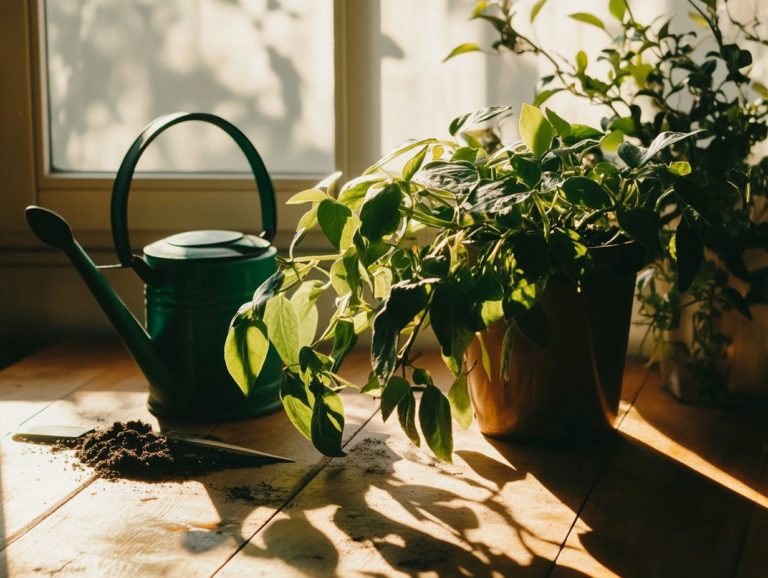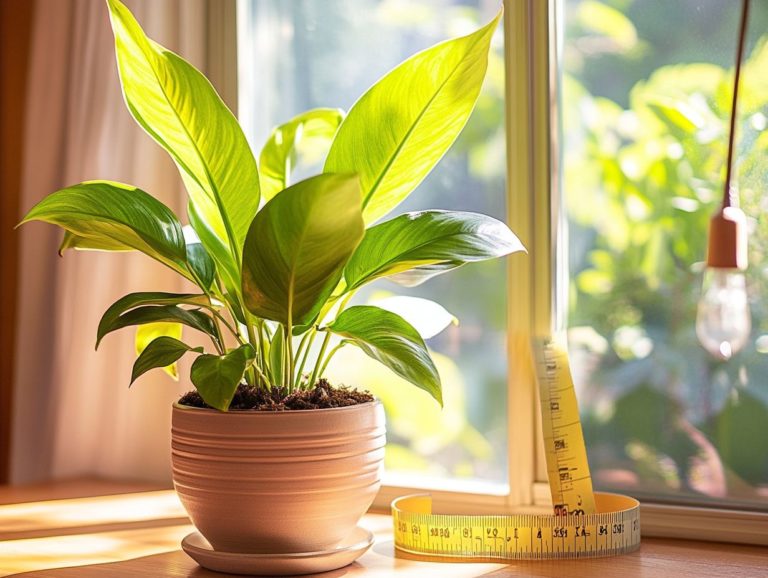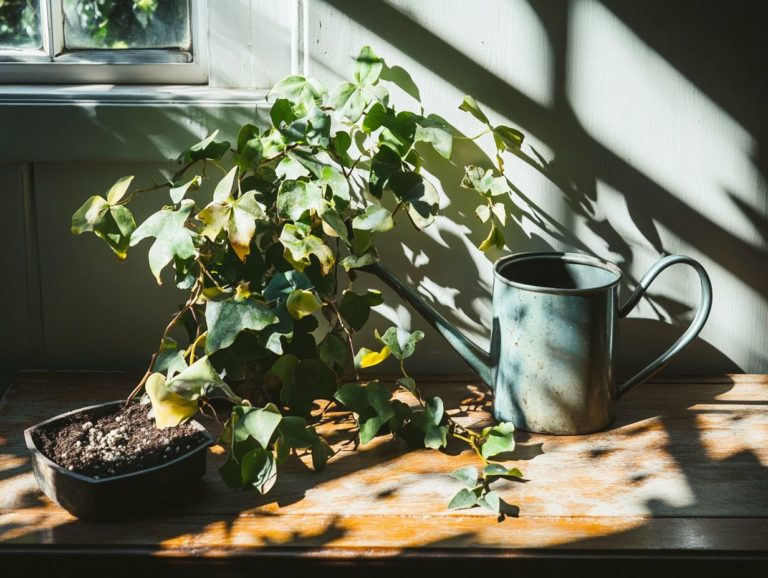How to Identify and Treat Leaf Blight
Leaf blight can be frustrating for gardeners and plant enthusiasts.
This guide will walk you through the symptoms of leaf blight, enabling you to identify the unmistakable signs that your plants might be affected.
It delves into the factors like too much moisture and lack of air flow that contribute to this issue and showcases effective treatment options, whether chemical or natural.
You ll gain insights into prevention strategies that will keep your plants thriving and recognize when it s time to consult a professional for severe cases.
Jump in to discover how to protect your plants from this ongoing threat!
Contents
- Key Takeaways:
- What is Leaf Blight?
- Symptoms of Leaf Blight
- Causes of Leaf Blight
- Treatment Options for Leaf Blight
- Preventing Leaf Blight
- Dealing with Severe Cases of Leaf Blight
- When to Seek Professional Help
- Frequently Asked Questions
- What is leaf blight and how does it affect plants?
- How can I identify leaf blight in my plants?
- What plants are most susceptible to leaf blight and other leaf spot diseases?
- How can I prevent leaf blight from infecting my plants?
- What should I do if I notice leaf blight on my plants?
- Can leaf blight be treated organically?
Key Takeaways:
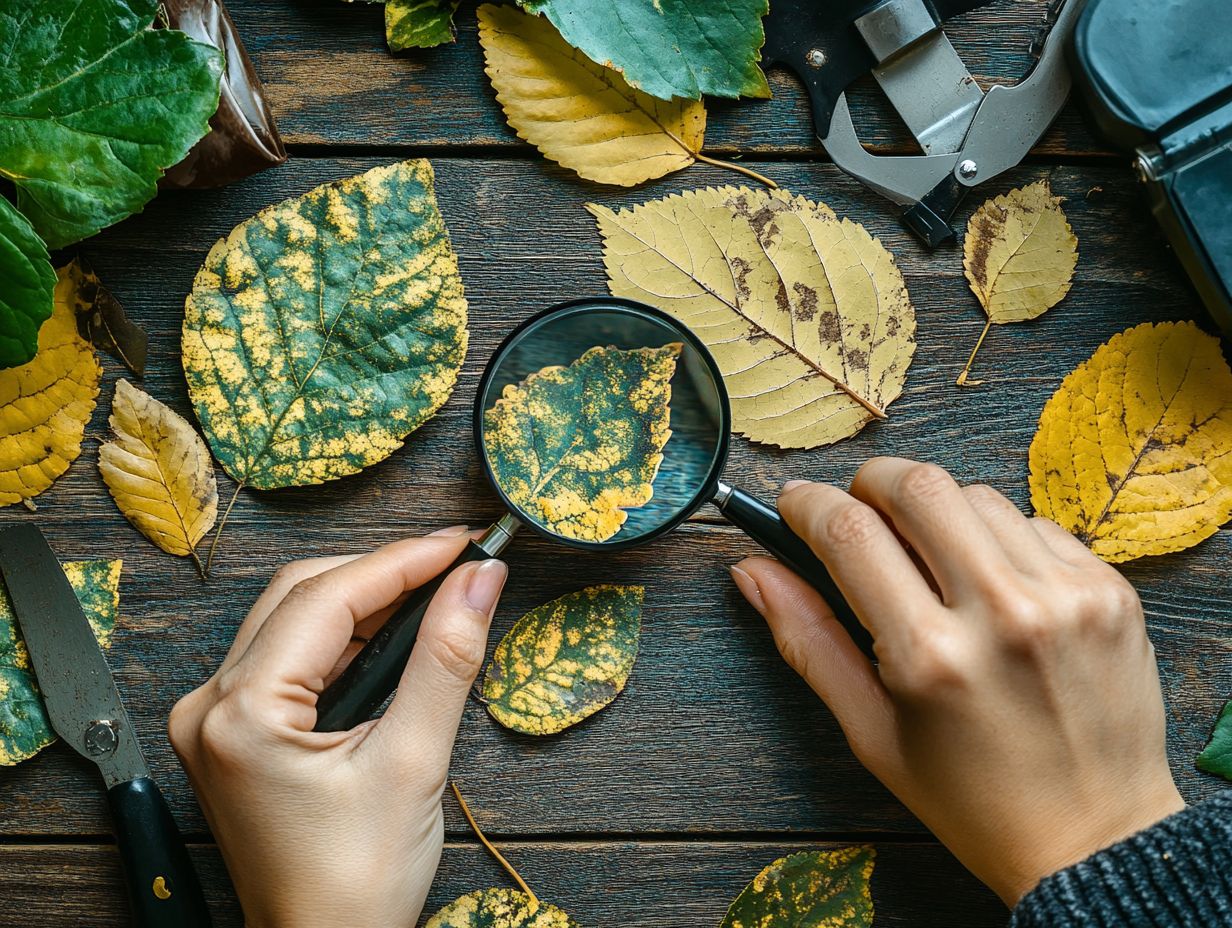
- Leaf blight is a common fungal infection that affects plants and trees, causing discoloration and wilting of leaves.
- Common symptoms of leaf blight include dark spots, yellowing, and eventual death of leaves.
- Seek professional help if leaf blight severely impacts your plants.
What is Leaf Blight?
Leaf blight is a prevalent fungal disease that targets a variety of grass types, including Kentucky bluegrass, perennial ryegrass, and tall fescue.
You ll notice its presence primarily through the cosmetic damage it inflicts on your lawn, leaving behind unsightly dry patches and unhealthy green blades. This condition is mainly caused by the Ascochyta fungus.
It can seriously affect your lawn s health if left unchecked, creating considerable challenges for turf recovery, especially in humid conditions, which can lead to summer outbreaks.
Symptoms of Leaf Blight
Recognizing the symptoms of leaf blight is essential for maintaining a healthy lawn. Look for signs like dry patches and green blades turning brown to recognize leaf blight.
By being attuned to these signs, you can take proactive measures to ensure your lawn remains vibrant and thriving.
Identifying Common Signs
Identifying common signs of leaf blight requires you to closely inspect your lawn for specific characteristics. Look for dry patches and any fungal signs, especially during humid conditions that can accelerate the spread of this disease.
Along with these indicators, you might notice yellowing leaves that ultimately turn brown or black at the edges, often curling or wilting under stress. Observing your lawn across different weather conditions is essential; for instance, early morning dew can reveal fungal growth that might otherwise escape your notice.
Implementing effective cultural practices gardening techniques that promote plant health can significantly aid in both the identification and prevention of leaf blight.
Ensuring proper irrigation, maintaining adequate air circulation, and practicing crop rotation are all key strategies. Regularly removing dead grass clippings and debris will also help lower moisture levels, creating an environment that is less hospitable to the development of this disease.
Causes of Leaf Blight
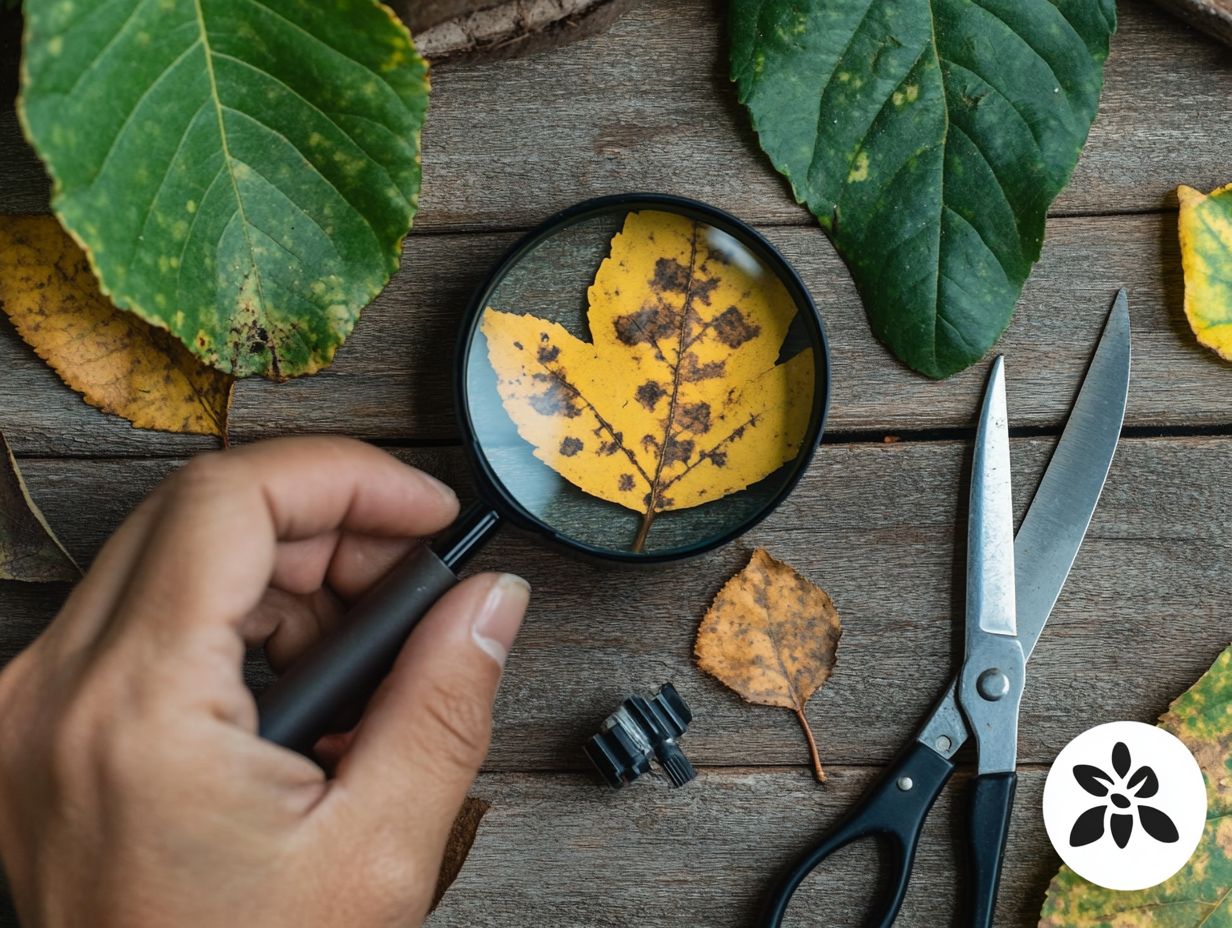
The origins of leaf blight can often be linked to a variety of environmental factors and cultural practices that foster the ideal conditions for fungal pathogens to thrive.
It becomes essential for you, as a lawn care professional, to identify and address these triggers effectively.
Environmental Factors and Contributing Agents
Environmental factors like soil compaction, inadequate irrigation practices, and excessive nitrogen fertilizer application play a significant role in the onset of leaf blight in grass.
These issues create an ideal breeding ground for pathogens. They obstruct airflow and moisture regulation both vital for maintaining healthy plants. When the soil is compacted, it restricts root development and limits access to essential nutrients.
Poor irrigation practices can cause drought stress or overly saturated conditions, both of which encourage fungal growth. Overusing nitrogen fosters lush, soft growth that is particularly vulnerable to disease.
Take action now to combat these challenges by implementing balanced cultural practices. Regular soil aeration, efficient irrigation techniques, and careful fertilizer application are essential. These practices not only improve soil health but also build resilience in your turf, ultimately reducing the chances of disease outbreaks.
Treatment Options for Leaf Blight
To effectively treat leaf blight, consider a blend of chemical and natural remedies. Lawn care professionals can leverage these options to restore turf health and reduce the impact of the Ascochyta fungus.
Chemical and Natural Remedies
Lawn care professionals often recommend a mix of chemical remedies and natural solutions to tackle leaf blight while helping your grass grow better.
Using fungicides chemicals used to kill fungi like chlorothalonil allows you to target fungal diseases precisely, ensuring that affected areas receive prompt and effective treatment. In contrast, natural alternatives, such as a baking soda solution, offer a gentler approach. This not only inhibits fungal spores but also safeguards the beneficial microorganisms within your soil.
When applying these treatments, remember to use the baking soda mixture during the early morning hours when dew is present, as this enhances its effectiveness.
Each method has unique advantages:
- Chemical treatments deliver swift results.
- Natural solutions contribute to long-term ecological health.
Relying solely on synthetic chemicals may lead to resistance, so it’s essential for homeowners to understand the limitations and make informed choices between these options.
Preventing Leaf Blight
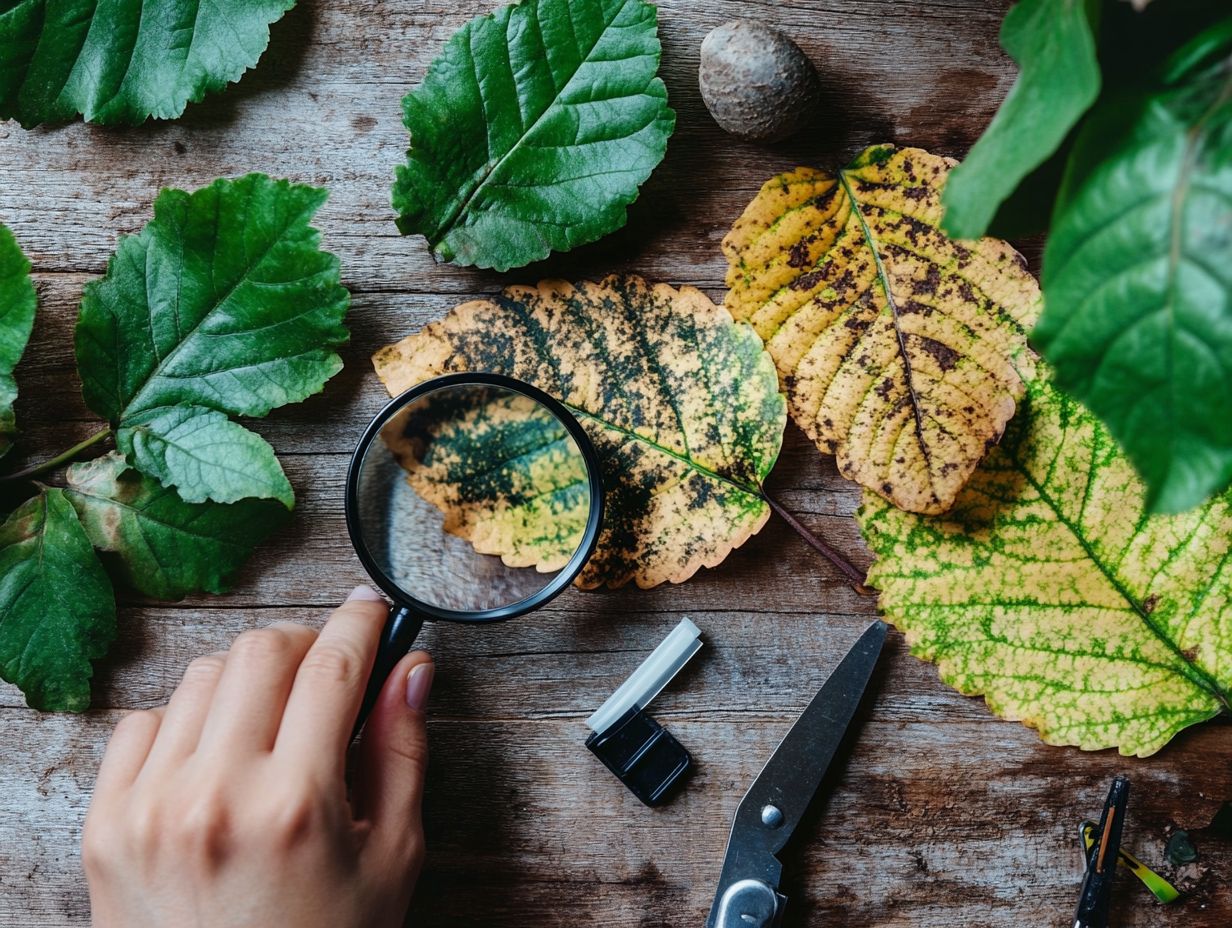
To prevent leaf blight, implement effective preventive measures through meticulous lawn care and cultural practices. Focus on enhancing soil health and optimizing your irrigation techniques to create an environment that discourages this issue.
Effective Strategies for Prevention
Implementing effective strategies to prevent leaf blight requires adherence to proper lawn maintenance techniques. This includes applying the right amount of nitrogen fertilizer and practicing optimal watering methods.
Beyond these fundamental practices, maintain a consistent lawn care schedule that incorporates regular mowing and aeration to enhance soil health. Keep an eye on environmental conditions like humidity and rainfall to anticipate potential outbreaks of leaf blight.
Using mulch is also a smart move; it retains soil moisture while preventing excessive thatch buildup, which can be a breeding ground for pathogens. Incorporating crop rotation and selecting resistant grass varieties will significantly reduce the chances of leaf blight taking hold.
By adopting a holistic approach with these cultural strategies, you’ll cultivate a healthy and resilient lawn. Start these practices today to ensure a healthy lawn!
Dealing with Severe Cases of Leaf Blight
When facing severe cases of leaf blight, seek professional assistance. Engaging experts can provide you with advanced treatment options that promote effective recovery of your lawn and tackle the underlying fungal disease head-on.
When to Seek Professional Help
Identifying the right moment to seek professional assistance for severe cases of leaf blight is crucial. This is especially true when conventional lawn treatment methods fail to deliver the desired recovery.
You may observe troubling signs such as wilting, yellowing leaves, or extensive patches of dead foliage that seem impervious to your watering or fertilization efforts. In these situations, it’s essential to reach out to lawn care experts. They can conduct a comprehensive diagnosis to pinpoint the underlying cause of the blight.
These professionals employ specialized tools and techniques that provide a more detailed analysis than typical home remedies.
When you consult them, expect to receive a customized treatment plan that may include chemicals used to kill fungi or nutritional amendments. They will also set realistic expectations regarding recovery timelines and the long-term health of your lawn. This ensures you are well-informed every step of the way.
This video provides valuable insights into leaf blight treatment.
Frequently Asked Questions

What is leaf blight and how does it affect plants?
Leaf blight is a fungal disease that affects the leaves of plants. It causes them to develop dark spots, eventually leading to withering and death. The disease can also spread to other parts of the plant, resulting in stunted growth and reduced yield.
How can I identify leaf blight in my plants?
The most common signs of leaf blight are dark, irregularly shaped spots or lesions on the leaves. These spots may have a yellow or brown border and could have a fuzzy appearance. In severe cases, the entire leaf may turn brown and wither.
What plants are most susceptible to leaf blight and other leaf spot diseases?
Leaf blight can affect a wide range of plants, including vegetables, fruits, flowers, and trees. Commonly affected plants include tomatoes, peppers, roses, corn, and oak trees.
How can I prevent leaf blight from infecting my plants?
To prevent leaf blight, plant disease-resistant varieties and maintain proper spacing between plants for good air circulation. Avoid over-fertilizing. It’s also important to water plants at the base to prevent getting the leaves wet, which helps reduce the spread of spores.
What should I do if I notice leaf blight on my plants?
If you notice leaf blight, remove any infected leaves and dispose of them in a sealed bag. Do not compost infected plant material. You can also apply a fungicide according to the label instructions to help control the spread of the disease.
Can leaf blight be treated organically?
Yes, there are organic methods for treating leaf blight, such as using a baking soda solution or neem oil spray. However, prevention is the best approach. It’s important to practice good cultural habits and regularly inspect your plants for signs of disease.




